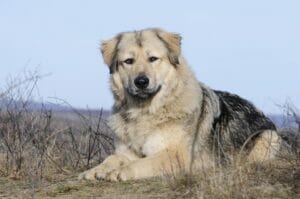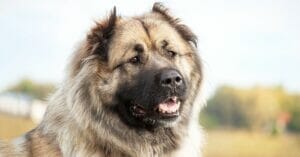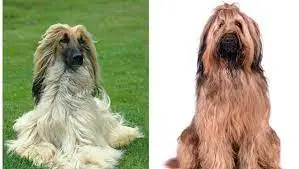Caucasian Shepherd – Mixed Dog Breed Characteristics & Facts

The Caucasian Shepherd Mixed Dog Breed is a fierce family protector who is devoted, sturdy, and brave. In the harsh Caucasus Mountains, they were bred to protect flocks and guard the house from savage predators. There are numerous varieties and types, and they go by many names, including Caucasian Mountain Dogs, Russian Bear Dogs, Baskhan (Karachay) Pariy, Caucasian Ovcharka Dogs, and simply CO.
Even when confronted by bears or wolves, this enormous breed won’t back down from a fight and is fiercely territorial. Although Caucasian Shepherd Dogs are intelligent, training them can be challenging due to their independent, stubborn nature. If a skilled trainer doesn’t keep them in check, their inherent mistrust of strangers and other animals can also result in aggressive tendencies.
Although Caucasian Shepherd Dogs are relatively low-energy dogs, their sheer size makes them unsuitable for apartments and homes with young children. This breed is not a good choice for inexperienced owners. Still, with proper training and socialization, Caucasian Shepherd Dogs can make strong watchdogs, family companions, and even therapy dogs.
While Caucasian Shepherd Dogs might not be a good fit for novice dog owners, they will reward skilled, understanding, and steadfast trainers with gentle love and affection that will make them wonderful lifelong family members. For a complete list of characteristics of Caucasian Shepherd Dogs, see below!
Caucasian Shepherd Mixed Dog Breed Picture






Caucasian Shepherd – Mixed Dog Breed Characteristics
| Adaptability | *** |
| Adapts Well To Apartment Living | ** |
| Good For Novice Owners | * |
| Sensitivity Level | ** |
| Tolerates Being Alone | *** |
| Tolerates Cold Weather | ***** |
| Tolerates Hot Weather | ** |
| All Around Friendliness | *** |
| Affectionate With Family | **** |
| Kid-Friendly | ** |
| Dog Friendly | ** |
| Friendly Toward Strangers | ** |
| Health And Grooming Needs | **** |
| Amount Of Shedding | **** |
| Drooling Potential | **** |
| Easy To Groom | ** |
| General Health | *** |
| Potential For Weight Gain | **** |
| Size | ***** |
| Trainability | *** |
| Easy To Train | ** |
| Intelligence | **** |
| Potential For Mouthiness | **** |
| Prey Drive | *** |
| Tendency To Bark Or Howl | *** |
| Wanderlust Potential | ** |
| Physical Needs | *** |
| Energy Level | ** |
| Intensity | **** |
| Exercise Needs | ** |
| Potential For Playfulness | *** |
Vital Stats:
| Dog Breed Group: | Working Dogs |
| Height: | 24 to 34 inches |
| Weight: | 80 to 220 pounds |
| Life Span: | 10 to 12 years |
The Caucasian Shepherd Dog is a fiercely devoted watchdog. These dogs were developed to assist shepherds in the Caucasus Mountains in protecting their flocks from wolves and bears. Today, they frequently use these instincts to serve as watchdogs and protectors, despite the fact that they can occasionally be overly wary of strangers and have trouble with other animals, including other dogs, invading their space.
The powerful Caucasian Shepherd Dog requires a skilled trainer who can manage an independent attitude with strict boundaries and patience. It is intelligent but headstrong. They are not energetic dogs, but because of their size, they need a lot of space, making apartments unsuitable for them.
The ideal yard has a sturdy, high fence. Although they don’t have a reputation for barking more than other dogs, their bark is quite loud and they will warn owners of any dangers, even in the middle of the night. Caucasian Shepherd Dogs can be wonderful family pets and should spend as much time indoors as possible with their owners.
They shouldn’t be chained outside; doing so will only breed dangerous, aggressive dogs. They can make devoted family pets and guardians with the right training, and some have even been taught how to be therapy dogs.
Highlights
- Because of the size of the Caucasus Mountain region and the diversity of needs of the local shepherds, different breed variations were developed to meet those needs. However, most kennel clubs consider the Caucasian Shepherd Dogs from Georgia to be the breed standard.
- Only once a year do female Caucasian Shepherd Dogs give birth.
- Shepherd in Caucasian Dogs are relatively low-energy dogs, but they are fierce protectors of their territory. A healthy diet and regular exercise should be used to prevent weight gain, which is a real possibility.
- This breed was employed by the communist USSR to protect prisoners, and dogs were kept in army kennels to develop new breeds for the military.
- East Germany used Caucasian Shepherd Dogs were given to German families to live out the rest of their lives when the wall came down.
- One of the oldest Molosser breeds is the Caucasian Shepherd Dog. Archaeological ruins have been found that link them to Mesopotamia.
- Three lengths and a plethora of colors are available for Caucasian Shepherd Dog coats. Even in extremely cold weather, their thick coats keep them warm despite the fact that they shed quite a bit.
- Although they are naturally wary of strangers and don’t get along with other animals, Caucasian Shepherd Dogs can be very gentle and loving. With the right training, some of them have even become therapy dogs.
History
The origin of these enormous, protective dogs is a little bit of a mystery, but the Caucasian Shepherd Dog is one of the oldest, most ancient Molasser breeds. They date back more than 2,000 years and come from the Caucasus Mountain range. Some people think they are descended from domesticated wolves, while others think Mastiffs and other breeds are also in their pedigree.
Although many experts contend that the Caucasian Shepherd Dog is descended from sheepdogs that migrated from Tibet, some recent archaeological evidence points to a Mesopotamian origin for the breed. Regardless of where they originated, Caucasian Shepherd Dogs have been an invaluable resource for shepherds in the Caucasus region for many years.
They fiercely protected sheep flocks and the people who owned them from dangerous animals like wolves, jackals, and bears. They needed to be able to withstand the cold and harsh conditions while also being fearless, intimidating, and strong. Because the Caucasus Mountain region is so large, many different variants of the breed emerged as shepherds bred the traits they needed into their dogs.
However, the Caucasian Shepherd Dogs that developed in Georgia eventually became the breed standard that is recognized by the majority of kennel clubs today. Sometime in the 1900s, the communist USSR started using Caucasian Shepherds as prisoner guard dogs and used them to develop other breeds in army kennels. East Germany used the breed as border patrol dogs along the Berlin Wall in the 1960s.
Approximately 7,000 patrol dogs were scattered when the Berlin Wall fell in 1989, and many of them were given to German families to live out the rest of their lives. Although they are still used by shepherds to tend to flocks, Caucasian Shepherd Dogs are now primarily used as household pets, watchdogs, and property guardians.
They require early socialization and strict training to prevent incidents because they still exhibit many of their cautious, distant, and occasionally aggressive traits. As the breed grows in popularity, breeders will probably try to eliminate some of the less desirable traits from it.
Size
The Caucasian Shepherd Dog is a huge dog. Males typically weigh 110 to 220 pounds, whereas females typically weigh 100 to 180 pounds. Males tend to be slightly larger than females. Depending on their origin or breed, some dogs may weigh more or less than others.
Plain dogs are a little bit leaner, while mountain dogs are more muscular. The height at the shoulder of a male is roughly 27 to 30 inches, while a female is between 25 and 28 inches. The Caucasian Shepherd Dog is regarded as a large breed.
Personality
The Caucasian Shepherd Dog is not appropriate for inexperienced pet owners. Although they are capable of being devoted, loving family dogs and fierce protectors, they also have a tendency to be wary of strangers and have trouble getting along with other dogs or animals that they are unfamiliar with.
They tend to be calm and low-key, but they are also fiercely territorial and won’t back down from a fight, even if it means facing off against a bear or wolf. Despite their intelligence, Caucasian Shepherd Dogs can be very stubborn, which can make training them challenging. They require strict limitations, tolerance, and consistency. Early socialization and training should both start as soon as possible in life.
To combat the breed’s tendency to become aggressive around unfamiliar people and animals, proper socialization training must be carried out. The Caucasian Shepherd is quite loving and loyal toward humans they are accustomed to, though, and will make a good lifelong guardian and protector.
Health
Although the Caucasian Shepherd Dog is generally regarded as a healthy breed, they can be susceptible to hip dysplasia, like many giant breeds. Cataracts may also form in them. Obesity is one of the most prevalent issues they experience.
Although they should be fed a diet suitable for a large breed, Caucasian Shepherd Dogs do not have particularly high energy levels, so that should be taken into account. They will require exercise, and veterinarians should keep an eye on their weight.
Consult your veterinarian or a nutritionist about developing an appropriate diet and an exercise plan to prevent obesity in your Caucasian Shepherd Dog. In order to prevent bloat, your veterinarian may advise feeding them smaller, more frequent meals throughout the day.
Care
Weight management through a healthy diet and regular exercise is the main type of care that Caucasian Shepherd Dogs require. Consult your veterinarian or nutritionist about these. Beyond that, Caucasian Shepherd Dogs should have their teeth professionally cleaned as advised by your veterinarian every two to three weeks.
At least once a week, you should check your ears for signs of debris or wax buildup and clean them as necessary. Ear infections could occur if this is not done. To avoid breaking and injury, nails should be clipped as needed. To avoid covering your house in slobber, you might also need to keep an eye out for drool and wipe it away when necessary.
Feeding
Shepherd in Caucasian Dogs should consume a diet designed for a giant breed with a moderate level of energy. Ask your veterinarian or a qualified nutritionist for assistance in determining the best type of food and serving size for your particular dog. From puppyhood to adulthood, the right diet will change, and it may be modified based on medical requirements.
Caucasian Shepherd Dogs have a slight tendency to overeat and put on weight, so be sure to follow the right meal recommendations. It might be advised to feed dogs smaller, more frequent meals to avoid the development of bloat, a potentially fatal condition.
Coat Design and Maintenance
Caucasian Shepherd Dogs have three different coat lengths: long, medium, and short. The mane and feathering around their tails and hind legs are more noticeable the longer their hair is. The three coat lengths are very thick. They have two coats, the undercoat being soft and fine, and the outer coat being longer and rougher.
The Caucasian Shepherd Dog can be solid white, gray, fawn, red, cream, or any of these colors. Additionally, brindled coats and large patches of two or more colors are both possible. They frequently have dark “masks” around their faces and white markings on their bodies. In order to get rid of loose or dead hairs and avoid matting, the thick coat should be brushed at least twice per week.
Every year, Caucasian Shepherd Dogs go through a significant shed. Bathing and additional brushing can hasten this shedding process. With a dog this size, bathing can be laborious, so it might be best to only do it when absolutely necessary or to hire a professional groomer.
Kids and other animals
Although Caucasian Shepherd Dogs are loyal and loving family pets who are even good with kids, it is crucial to start socialization training them early on. They are naturally wary of strangers, sometimes even to the point of aggression, and they do not get along with other dogs unless they have received the proper socialization.
Caucasian Shepherds tend to be territorial and aggressive to other dogs unless they have been raised with them, so visiting children will need a calm, proper introduction with known humans present. They may become aggressive toward young children due to their natural herding instincts, and they may interpret rough play from unfamiliar children as an assault on a member of their human family.
The Caucasian Shepherd Dog, which was bred to be intimidating, won’t think twice to defend their family and home from perceived threats. Children should be watched during playtime and taught proper animal handling skills, just like with any dog, to prevent mishaps.
Even with a trained Caucasian Shepherd, their size could be a problem, so it’s important to keep an eye on them to prevent play from getting out of control and leading to injuries. Homes without other pets and with older children may be the best environments for Caucasian Shepherd Dogs.
Rescue Teams
You might want to follow Caucasian Ovcharka Rescue Rehome USA on Facebook if you’re interested in adopting a Caucasian Shepherd Dog as they specialize in doing so. Additionally, you can search for adoptable dogs by breed and location on our adoption page or by visiting nearby animal shelters.
Creator: PetsCareTip






